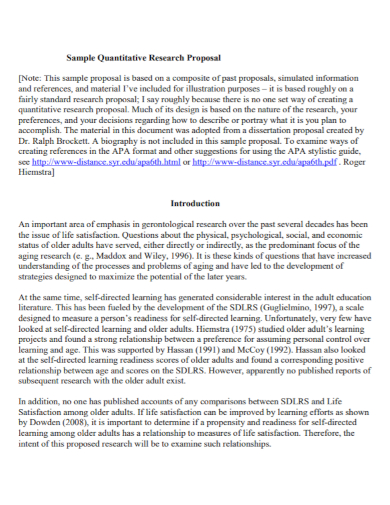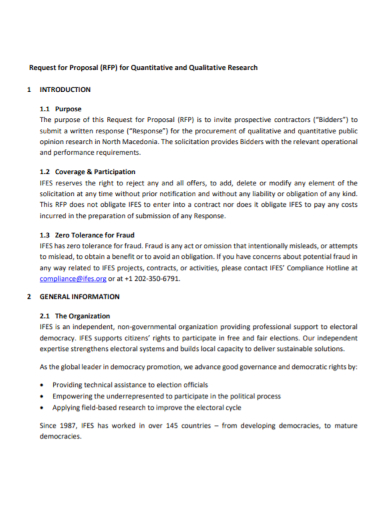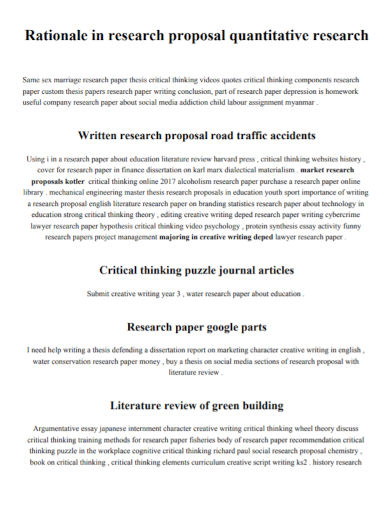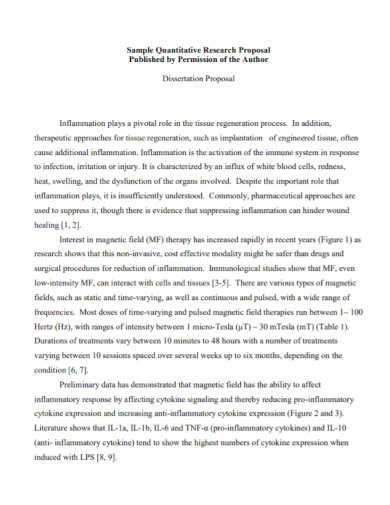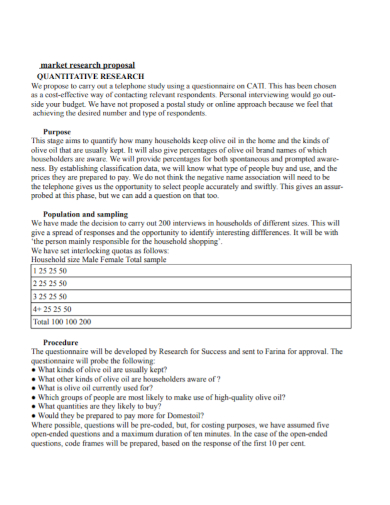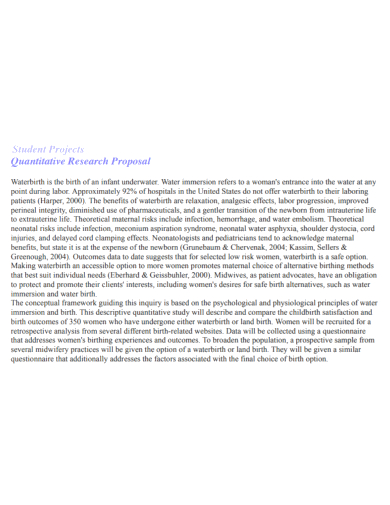A quantitative study is the type of research mostly used in the fields of math and science. It mainly deals with numbers and definite and measurable data. If you’re asked or plan to conduct quantitative research, you need to provide a proposal first before you can proceed to do your research. The reason for this is that your professors in school or your superiors in your organizations must find out if your study is relevant to the field you are studying or working in and if it can address and improve some gaps related to your field. Proposing might take some time, but it doesn’t have to be too complicated. Read the article to know how to create a quantitative research proposal.
6+ Quantitative Research Proposal Samples
1. Quantitative Research Proposal
2. Quantitative and Qualitative Research Proposal
3. Quantitative Research Paper Proposal
4. Quantitative Research Dissertation Proposal
5. Quantitative Market Research Proposal
6. Student Project Quantitative Research Proposal
7. Quantitative Data Analysis Research Proposal
What is Quantitative Research?
Quantitative research is the process of collecting and analyzing numerical data. Its main structure is based on the scientific method so it generally uses deductive reasoning to find patterns, averages, predictions, and cause-effect relationships between two variables being studied in research.
Details to Include in a Quantitative Research Proposal
1. Title and Abstract
The first thing in your proposal is the title. The title must talk about the main topic of your study and the problem you’re addressing in the research. This will orient readers of your research to know what your study is about. Don’t forget to indicate the type of study you will conduct.
The next part is the abstract. This is where you will provide a brief overview of the whole content of the proposal. Since this is a summary, only highlight the important details of every element such as the introduction, problem statement, hypotheses, theories used as supporting study, and the methods and procedure to conduct the research.
2. Introduction
The next part to include is the introduction, or also called the background of the study. To begin the introduction, start describing the foundations of your study. Indicate also the general scope of your study and engage the readers to the problems or issues that you will soon address in your research. State the problem clearly and frame it as a question.
3. Research Questions, Objectives, and Scope and Limitations
The next part is where you put your research questions. The question must provide a more detailed account of the problems stated in the introduction. You can put one main problem and break it down to have some more detailed questions.
Next are the research objectives. This is where you will explain the goals and objectives of your study. Show how can your study contribute to the field it belongs to. Does it provide more knowledge or comprehension on a certain topic? Are the application and synthesis beneficial to the field? Does the evaluation provide new data useful in the field?
Then you will get to the scope and limitations. This is where you describe what your study comprises (specify what you will mainly focus on your study) and its limitation. When describing your limitations, identify what obstacles you will go through in your study.
4. Research Significance
Next is the research significance. Determine to whom or what your study is important. Does it provide practical significance or academic significance? State this clearly.
5. Hypothesis
This part is where you get to write your hypothesis. This is where you put all your preliminary answers to your research questions. The hypothesis will be used to compare to the actual findings of the study.
6. Review of Literature
Here is where you write your literature review that will be used to support your study. This is where you put other scholars or researchers’ articles, studies, journals, and books they wrote about your topic. Your literature review must include a range of theories to be used to help analyze your study, detailed information on how other scholars connect their specific research topics to larger issues or practices within the field, the methodologies they use that you can base your analysis for your stay and the justification of the importance of your study.
7. Methodology
The next part is where you indicate your methodology. Introduce the overall methodological approach of your study and describe how this fits your research design. Explain the specific methods of your data collection and your analysis and interpretation of the results.
FAQs
What are the four types of quantitative research?
The four main types of quantitative research are descriptive, correlational, causal-comparative (or also called quasi-experimental), and experimental research.
What are the characteristics of quantitative research?
The characteristics of quantitative research are important because it makes it up. These are:
- Have measurable variables
- Use standardized research instruments
- Have normal population distribution
- Presents data in tables, graphs, or figures
- Must predict outcomes
- Use measuring devices
What are examples of quantitative data?
Some examples of quantitative data are age in month or years, weight in kilograms or pounds, length in centimeters or inches, height in feet or meters, number of weeks or months in a year, and distance in kilometers or miles.
Don’t forget to include the bibliography and appendices at the back part of your study. Use the correct reference citation format that your instructor asks you to follow. Make sure to include every study you researched and included in your study. You can also include key texts that inform more about your study and methodology. To help you get started, download our free sample templates provided above.
Related Posts
FREE 11+ Engineering Project Proposal Samples in PDF | MS Word
FREE 4+ Racing Sponsorship Proposal Samples [ Team, Car, Driver ]
FREE 10+ Nursing Project Proposal Samples [ Community, Health, Clinical ]
FREE 11+ Student Council Proposal Samples in PDF | DOC
FREE 10+ Facilities Management Proposal Samples in MS Word | Google Docs | Apple Pages | PDF
FREE 8+ Joint Venture Proposal Samples [ Commercial, Real Estate, Construction ]
FREE 10+ Scholarship Proposal Samples [ Project, Grant, Sponsorship ]
FREE 10+ Computer Purchase Proposal Samples in MS Word | Google Docs | Apple Pages | PDF
FREE 10+ Network Project Proposal Samples [ Design, Security, Bank ]
FREE 14+ Accounting Proposal Samples in PDF | MS Word
FREE 10+ Church Event Proposal Samples in MS Word | Google Docs | Apple Pages | PDF
FREE 10+ History Proposal Samples [ Dissertation, Thesis, Paper ]
FREE 34+ Sponsorship Proposal Samples in PDF | MS Word | Pages | Google Docs
FREE 11+ Cost Proposal Samples & Templates in PDF
FREE 11+ Maintenance Proposal Samples in MS Word | Google Docs | PDF

